NICOTROL- nicotine spray, metered
Nicotrol by
Drug Labeling and Warnings
Nicotrol by is a Prescription medication manufactured, distributed, or labeled by Pharmacia and Upjohn Company LLC. Drug facts, warnings, and ingredients follow.
Drug Details [pdf]
- SPL UNCLASSIFIED SECTION
-
DESCRIPTION
Nicotrol® NS (nicotine nasal spray) is an aqueous solution of nicotine intended for administration as a metered spray to the nasal mucosa.
Nicotine is a tertiary amine composed of pyridine and a pyrrolidine ring. It is a colorless to pale yellow, freely water-soluble, strongly alkaline, oily, volatile, hygroscopic liquid obtained from the tobacco plant. Nicotine has a characteristic pungent odor and turns brown on exposure to air or light. Of its two stereoisomers, S(-)nicotine is the more active. It is the prevalent form in tobacco, and is the form in NICOTROL NS. The free alkaloid is absorbed rapidly through skin, mucous membranes, and the respiratory tract.
Chemical Name: S-3-(1-methyl-2-pyrrolidinyl) pyridine
Molecular Formula: C10H14N2
Molecular Weight: 162.23
Ionization Constants: pKa1 = 7.84, pKa2 = 3.04 at 15°C
Octanol-Water Partition Coefficient: 15:1 at pH 7
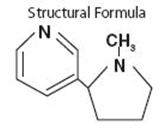
Each 10 mL spray bottle contains 100 mg nicotine (10 mg/mL) in an inactive vehicle containing disodium phosphate, sodium dihydrogen phosphate, citric acid, methylparaben, propylparaben, edetate disodium, sodium chloride, polysorbate 80, aroma and water. The solution is isotonic with a pH of 7. It contains no chlorofluorocarbons.
After priming the delivery system for NICOTROL NS, each actuation of the unit delivers a metered dose spray containing approximately 0.5 mg of nicotine. The size of the droplets produced by the unit is in excess of 8 microns. One NICOTROL NS unit delivers approximately 200 applications.
-
CLINICAL PHARMACOLOGY
Pharmacologic Action
Nicotine, the chief alkaloid in tobacco products, binds stereo-selectively to nicotinic-cholinergic receptors at the autonomic ganglia, in the adrenal medulla, at neuromuscular junctions, and in the brain. Two types of central nervous system effects are believed to be the basis of nicotine's positively reinforcing properties. A stimulating effect is exerted mainly in the cortex via the locus ceruleus and a reward effect is exerted in the limbic system. At low doses, the stimulant effects predominate while at high doses the reward effects predominate. Intermittent intravenous administration of nicotine activates neurohormonal pathways, releasing acetylcholine, norepinephrine, dopamine, serotonin, vasopressin, beta-endorphin, growth hormone, and ACTH.
Pharmacodynamics
The cardiovascular effects of nicotine include peripheral vasoconstriction, tachycardia, and elevated blood pressure. Acute and chronic tolerance to nicotine develops from smoking tobacco or ingesting nicotine preparations. Acute tolerance (a reduction in response for a given dose) develops rapidly (less than 1 hour), but not at the same rate for different physiologic effects (skin temperature, heart rate, subjective effects). Withdrawal symptoms such as cigarette craving can be reduced in most individuals by plasma nicotine levels lower than those from smoking.
Withdrawal from nicotine in addicted individuals can be characterized by craving, nervousness, restlessness, irritability, mood lability, anxiety, drowsiness, sleep disturbances, impaired concentration, increased appetite, minor somatic complaints (headache, myalgia, constipation, fatigue), and weight gain. Nicotine toxicity is characterized by nausea, abdominal pain, vomiting, diarrhea, diaphoresis, flushing, dizziness, disturbed hearing and vision, confusion, weakness, palpitations, altered respiration and hypotension.
Both smoking and nicotine can increase circulating cortisol and catecholamines, and tolerance does not develop to the catecholamine-releasing effects of nicotine. Changes in the response to a concomitantly administered adrenergic agonist or antagonist should be watched for when nicotine intake is altered during NICOTROL NS therapy and/or smoking cessation (See PRECAUTIONS, Drug Interactions).
PHARMACOKINETICS
Each actuation of NICOTROL NS delivers a metered 50 microliter spray containing approximately 0.5 mg of nicotine. One dose is considered 1 mg of nicotine (2 sprays, one in each nostril).
Absorption
Following administration of 2 sprays of NICOTROL NS approximately 53% ± 16% (Mean ± SD) enters the systemic circulation. No significant difference in rate or extent of absorption could be seen due to the deposition of nicotine on different parts of the nasal mucosa. Plasma concentrations of nicotine obtained from 1 dose (1 mg nicotine) of NICOTROL NS rise rapidly, reaching maximum venous concentrations of 2–12 ng/mL in 4–15 minutes. The apparent absorption half-life of nicotine is approximately 3 minutes. There is wide variation among subjects in their plasma nicotine concentrations from the spray. As a result, after a 1 mg dose of spray approximately 20% of the subjects reached peak nicotine concentrations similar to those seen after smoking one cigarette (7–17 ng/mL) (See DRUG ABUSE AND DEPENDENCE Section). Figure 1 below plots the mean and 5th and 95th percentile nicotine concentrations after a 1 mg single dose of the nasal spray (n=30).
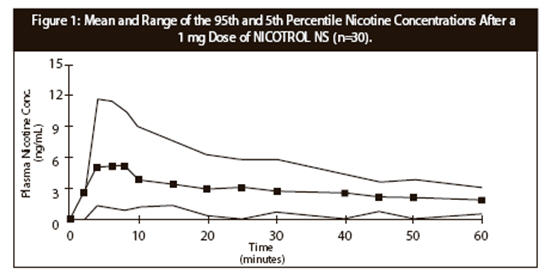
Table 1: Trough Plasma Nicotine Concentrations after 11 Hours of Dosing With 1 mg, 2 mg and 3 mg of NICOTROL NS per hour (n=16). Dose Mean (ng/mL) ± SD (Range) 1 mg every 60 minutes (1 mg/hr) 6 ± 3 (1.7–12) 1 mg every 30 minutes (2 mg/hr) 14 ± 6 (1.5–24) 1 mg every 20 minutes (3 mg/hr) 18 ± 10 (1.2–35) The data from Table 1 is derived from a three-way cross-over study of repeated applications of NICOTROL NS in sixteen smokers (8 male, 8 female) ranging in age from 18 to 48 years. There is a slight deviation from dose-concentration proportionality from one dose to three doses of NICOTROL NS per hour as shown in Figure 2.
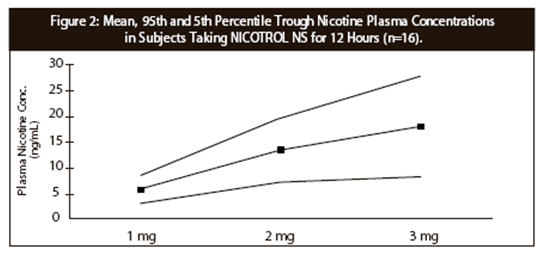
Sixteen smokers (7 males and 9 females) ranging in age from 22 to 44 years were dosed with 1 mg of NICOTROL NS every hour for 10 hours. The pharmacokinetic parameters that were obtained are presented in Table 2.
Table 2: Nicotine Pharmacokinetic Parameters at Steady-State for 1 mg/hour of NICOTROL NS Administered Hourly for Ten Hours (Mean ± SD and Range), (n=16). Parameter 1 mg (2 sprays) (Range) Cavg: average plasma nicotine concentration for the dosing interval of 10–11 hours Cmax: maximum measured plasma concentration after last dose administration Tmax: time of maximum plasma concentration after last dose administration Cavg (ng/mL) 8 ± 3 (2.5–12) Cmax (ng/mL) 9 ± 3 (3.1–14) Tmax (minutes) 13 ± 5 (10–20) Distribution
The volume of distribution following IV administration of nicotine is approximately 2 to 3 L/kg. Plasma protein binding of nicotine is <5%. Therefore, changes in nicotine binding from use of concomitant drugs or alterations of plasma proteins by disease states would not be expected to have significant effects on nicotine kinetics.
Metabolism
More than 20 metabolites of nicotine have been identified, all of which are less active than the parent compound. The primary urinary metabolites are cotinine (15% of the dose) and trans-3-hydroxycotinine (45% of the dose). Cotinine has a half-life of 15 to 20 hours and concentrations that exceed nicotine by 10-fold. The major site for the metabolism of nicotine is the liver. The kidney and lung are also sites of nicotine metabolism.
Elimination
About 10% of the nicotine absorbed is excreted unchanged in the urine. This may be increased to up to 30% with high urine flow rates and urinary acidification below pH 5. The average plasma clearance is about 1.2 L/min in a healthy adult smoker. The apparent elimination half-life of nicotine from NICOTROL NS is 1 to 2 hours.
Pharmacokinetic Model
The data were well described by a two-compartment model with first-order input.
Based on individual fits (N=18) the following parameters were derived after the administration of a 1 mg dose: Absorption rate constant (Ka) = 14.4 ± 7.3 hr-1 (Mean ± SD), Elimination rate constant (Ke) = 0.60 ± 0.53 hr-1, Distribution rate constants (K12) = 4.84 ± 2.57 hr-1, (K21) = 4.35 ± 2.30 hr-1, Volume of distribution over fraction absorbed (V/F) = 2.73 ± 0.82 L/kg in 8 female and 10 male adults weighing 76 ± 15 kg.
Gender Differences
Intersubject variability (50% coefficient of variation) among the pharmacokinetic parameters (AUC, Cmax and Clearance/kg) were observed for both genders. There were no differences between females or males in the kinetics of NICOTROL NS.
Renal Impairment
Progressive severity of renal impairment is associated with decreased total clearance of nicotine. Nicotine clearance was decreased by 30% on average in subjects with moderate renal impairment and 50% on average in subjects with severe renal impairment.
Hepatic Impairment
In smokers with liver cirrhosis but only mild impairment of hepatic function (Child-Pugh score 5), the pharmacokinetics of nicotine is unaffected. However, in smokers with moderately impaired liver function (Child-Pugh score 7), total clearance has been reported to be reduced on average by 40-50%. There are no data about the pharmacokinetics of nicotine in smokers with a Child-Pugh score exceeding 7, but these subjects are expected to show similar or greater effects on clearance of nicotine as patients with moderately impaired liver function.
Drug/Drug Interactions
The extent of absorption is slightly reduced (approximately 10%) in patients with the common cold/rhinitis. In patients with rhinitis the peak plasma concentration is reduced by approximately 20% (concentrations are lower by 1.5 ng/mL on average) and the time to peak concentration prolonged by approximately 30% (delayed by 7 minutes on average). The use of a nasal vasoconstrictor such as xylometazoline in patients with rhinitis will further prolong the time to peak by approximately 40% (delayed by 15 minutes on average), but the peak plasma concentration remains on average the same as those with rhinitis.
-
CLINICAL TRIALS
The efficacy of NICOTROL NS therapy as an aid to smoking cessation was demonstrated in three single-center, placebo-controlled, double-blind trials with a total of 730 patients. One of the trials used NICOTROL NS with individual counseling while the other two used group support. Patients with severe or symptomatic cardiovascular disease, hypertension, asthma, diabetes or severe allergy were not included in the studies. The amount of NICOTROL NS used was left to the discretion of each patient, with a minimum dose of 8 mg/day and a maximum dose of 40 mg/day.
In all three studies, the recommended duration of treatment was 3 months; however in two of these trials, 241 patients were permitted to continue to use the product for up to 1 year, if they wished. Among the 64 patients abstinent from cigarettes at the end of a year, 23 (36%) were still using the spray, and probable dependence on the spray was seen in several patients (See DRUG ABUSE AND DEPENDENCE).
Quitting was defined as total abstinence from smoking for at least 4 weeks. The "quit rates" are the percentage of all persons initially enrolled who continuously abstained after week 2 or 4.
In all three studies, NICOTROL NS was more effective than placebo at 6 weeks, 3 months, 6 months, and 1 year. The two studies where NICOTROL NS could be used for more than 6 months did not have a better outcome at 1 year than the study in which NICOTROL NS was discontinued at 6 months.
Table 3: Quit Rates by Treatment (N=730 smokers in 3 Studies) Group Size (n) At 6 Weeks At 3 Months At 6 Months At 1 Year NICOTROL NS 369 49–58% 41–45% 31–35% 23–27% Placebo 361 21–32% 17–20% 12–15% 10–15% Patients treated with NICOTROL NS had more relief of the urge to smoke and withdrawal symptoms compared with placebo-treated patients.
NICOTROL NS allows the patient to vary the dose of nicotine on a short-term basis. As with other variable dose smoking cessation products, NICOTROL NS may be useful in the management of highly dependent smokers.
-
INDICATIONS AND USAGE
NICOTROL NS is indicated as an aid to smoking cessation for the relief of nicotine withdrawal symptoms. NICOTROL NS therapy should be used as a part of a comprehensive behavioral smoking cessation program.
The safety and efficacy of the continued use of NICOTROL NS for periods longer than 6 months have not been adequately studied and such use is not recommended.
- CONTRAINDICATIONS
-
WARNINGS
Nicotine from any source can be toxic and addictive. Smoking causes lung disease, cancer, and heart disease and may adversely affect pregnant women or the fetus. For any smoker, with or without concomitant disease or pregnancy, the risk of nicotine replacement in a smoking cessation program should be weighed against the hazard of continued smoking, and the likelihood of achieving cessation of smoking without nicotine replacement.
Pregnancy, Warning
Tobacco smoke, which has been shown to be harmful to the fetus, contains nicotine, hydrogen cyanide, and carbon monoxide. Nicotine has been shown in animal studies to cause fetal harm. It is therefore presumed that NICOTROL NS can cause fetal harm when administered to a pregnant woman. The effect of nicotine delivery by NICOTROL NS has not been examined in pregnancy (See PRECAUTIONS). Therefore, pregnant smokers should be encouraged to attempt cessation using educational and behavioral interventions before using pharmacological approaches. If NICOTROL NS is used during pregnancy, or if the patient becomes pregnant while using it, the patient should be apprised of the potential hazard to the fetus.
Safety Note Concerning Children
The amounts of nicotine that are tolerated by adult smokers can produce signs and symptoms of poisoning and could prove fatal if NICOTROL NS is used or ingested by children or pets. Suspected nicotine poisoning in a child should be considered a medical emergency and treated immediately. A full bottle of NICOTROL NS contains 100 mg of nicotine, some of which will still be in the bottle when it is discarded. Therefore, patients should be cautioned to keep both used and unused containers of NICOTROL NS out of the reach of children and pets.
-
PRECAUTIONS
General
The patient should be urged to stop smoking completely when initiating NICOTROL NS therapy (See DOSAGE AND ADMINISTRATION). Patients should be informed that if they continue to smoke while using the product, they may experience adverse effects due to peak nicotine levels higher than those experienced from smoking alone. If there is a clinically significant increase in cardiovascular or other effects attributable to nicotine, the treatment should be discontinued (See WARNINGS). Physicians should anticipate that concomitant medications may need dosage adjustment (See Drug Interactions).
Sustained use (beyond 6 months) of NICOTROL NS by patients who stop smoking is not recommended and should be discouraged (See DRUG ABUSE AND DEPENDENCE).
Care should be taken not to spray the eyes while administering NICOTROL NS.
Asthma, Bronchospasm and Reactive Airway Disease
Exacerbation of bronchospasm in patients with pre-existing asthma has been reported. Use of NICOTROL NS in patients with severe reactive airway disease is not recommended. In a small clinical study of 33 subjects, use of NICOTROL NS by smokers with chronic rhinitis and sinusitis was associated with irritant effects with no significant impairment in nasal condition.
Effect of NICOTROL NS on the Nasal Mucosa
Topical application of either nicotine or tobacco products is irritating to the nasal mucosa and physicians should consider both the risks and benefits to the patient before initiating or continuing NICOTROL NS therapy.
The effect of NICOTROL NS on the nasal mucosa was studied in 39 cigarette smokers who used NICOTROL NS for 1 month. When compared to baseline, random biopsies taken after four weeks of treatment revealed 1 patient with persistence of pre-existing dysplasia and 1 patient with a newly found dysplasia. In both, dysplasia was not seen after a recovery period of eight weeks.
Forty-two patients who used NICOTROL NS for more than 6 months underwent follow-up ear, nose and throat examinations 1 to 3 months after discontinuing the use of the spray. Many reported local irritant effects of the spray during spray use, but none showed persistent mucosal injury that the examining physician could attribute to use of the product.
The clinical significance of these findings is not known, but extended use of the product beyond six months is not recommended.
Cardiovascular or Peripheral Vascular Diseases
The risks of nicotine replacement in patients with cardiovascular and peripheral vascular diseases should be weighed against the benefits of including nicotine replacement in a smoking cessation program for them. Specifically, patients with coronary heart disease (history of myocardial infarction and/or angina pectoris), serious cardiac arrhythmias, or vasospastic diseases (Buerger's disease, Prinzmetal's variant angina and Raynaud's phenomena) should be evaluated carefully before nicotine replacement is prescribed.
Tachycardia occurring in association with nicotine replacement therapy has been reported. No serious cardiovascular events were reported in clinical studies with NICOTROL NS, but if symptoms occur, its use should be discontinued.
NICOTROL NS generally should not be used in patients during the immediate postmyocardial infarction period, nor in patients with serious arrhythmias, or with severe or worsening angina.
Renal or Hepatic Insufficiency
Pharmacokinetic studies in patients with moderate to severe renal impairment or moderate to severe hepatic impairment have shown decreased nicotine clearance. The pharmacokinetics of nicotine have not been studied in the elderly. Given that nicotine is extensively metabolized and that its total system clearance is dependent on liver blood flow, some influence of hepatic impairment on drug kinetics (reduced clearance with potential for increased adverse effects) are anticipated. Moderate and severe renal impairment would be expected to affect the clearance of nicotine or its metabolites from the circulation (See PHARMACOKINETICS). Consider dose reduction and monitoring patients for adverse events (such as nausea or dizziness) associated with elevated levels of nicotine.
Endocrine Diseases
NICOTROL NS therapy should be used with caution in patients with hyperthyroidism, pheochromocytoma or insulin-dependent diabetes, since nicotine causes the release of catecholamines by the adrenal medulla.
Peptic Ulcer Disease
Nicotine delays healing in peptic ulcer disease; therefore, NICOTROL NS therapy should be used with caution in patients with esophagitis, active gastric or peptic ulcers and only when the benefits of including nicotine replacement in a smoking cessation program outweigh the risks.
Accelerated Hypertension
Nicotine therapy constitutes a risk factor for development of malignant hypertension in patients with accelerated hypertension; therefore, NICOTROL NS therapy should be used with caution in these patients and only when the benefits of including nicotine replacement in a smoking cessation program outweigh the risks.
Information To Patient
A patient instruction sheet is included in the package of NICOTROL NS dispensed to the patient. Patients should be encouraged to read the instruction sheet carefully and to ask their physician and pharmacist about the proper use of the product (See DOSAGE AND ADMINISTRATION).
It should be explained to patients that they are likely to experience nasal irritation, which may become less bothersome with continued use.
Patients must be advised to keep both used and unused containers out of the reach of children and pets.
Drug Interactions
The extent of absorption and peak plasma concentration is slightly reduced in patients with the common cold/rhinitis. In addition, the time to peak concentration is prolonged. The use of a nasal vasoconstrictor such as xylometazoline in patients with rhinitis will further prolong the time to peak (See PHARMACOKINETICS). Smoking cessation, with or without nicotine replacement, may alter the pharmacokinetics of certain concomitant medications.
May Require a Decrease in Dose at Cessation of Smoking Possible Mechanism Acetaminophen, caffeine, imipramine, oxazepam, pentazocine, propranolol, or other beta-blockers, theophylline Deinduction of hepatic enzymes on smoking cessation. Insulin Increase of subcutaneous insulin absorption with smoking cessation. Adrenergic antagonists (e.g. prazosin, labetalol) Decrease in circulating catecholamines with smoking cessation. May Require an Increase in Dose at Cessation of Smoking Possible Mechanism Adrenergic agonists (e.g. isoproterenol, phenylephrine) Decrease in circulating catecholamines with smoking cessation. Carcinogenesis, Mutagenesis, Impairment Of Fertility
Nicotine itself does not appear to be a carcinogen in laboratory animals. However, nicotine and its metabolites increased the incidences of tumors in the cheek pouches of hamsters and forestomach of F344 rats, respectively, when given in combination with tumor-initiators. One study, which could not be replicated, suggested that cotinine, the primary metabolite of nicotine, may cause lymphoreticular sarcoma in the large intestine of rats.
Neither nicotine nor cotinine were mutagenic in the Ames salmonella test. Nicotine-induced repairable DNA damage in an E. coli test system. Nicotine was shown to be genotoxic in a test system using Chinese hamster ovary cells. In rats and rabbits, implantation can be delayed or inhibited by a reduction in DNA synthesis that appears to be caused by nicotine. Studies have shown a decrease in litter size in rats treated with nicotine during gestation.
PREGNANCY
The harmful effects of cigarette smoking on maternal and fetal health are clearly established. These include low birth weight, an increased risk of spontaneous abortion, and increased perinatal mortality. The specific effects of NICOTROL NS on fetal development are unknown. Therefore pregnant smokers should be encouraged to attempt cessation using educational and behavioral interventions before using pharmacological approaches.
Spontaneous abortion during nicotine replacement therapy has been reported; as with smoking, nicotine as a contributing factor cannot be excluded.
NICOTROL NS should be used during pregnancy only if the likelihood of smoking cessation justifies the potential risk of using it by the pregnant patient, who might continue to smoke.
Teratogenicity
Other Effects
Animal Studies
A nicotine bolus (up to 2 mg/kg) to pregnant rhesus monkeys caused acidosis, hypercarbia, and hypotension (fetal and maternal concentrations were about 20 times those achieved after smoking one cigarette in 5 minutes). Fetal breathing movements were reduced in the fetal lamb after intravenous injection of 0.25 mg/kg nicotine to the ewe (equivalent to smoking 1 cigarette every 20 seconds for 5 minutes). Uterine blood flow was reduced about 30% after infusion of 0.1 µg/kg/min nicotine to pregnant rhesus monkeys (equivalent to smoking about six cigarettes every minute for 20 minutes).
Human Experience
Cigarette smoking during pregnancy is associated with an increased risk of spontaneous abortion, low birth weight infants and perinatal mortality. Nicotine and carbon monoxide are considered the most likely mediators of these outcomes. The effects of cigarette smoking on fetal cardiovascular parameters have been studied near term. Cigarettes increased fetal aortic blood flow and heart rate and decreased uterine blood flow and fetal breathing movements. NICOTROL NS has not been studied in pregnant women.
Labor and Delivery
NICOTROL NS is not recommended for use during labor and delivery. The effect of nicotine on a mother or the fetus during labor is unknown.
Use in Nursing Mothers
Caution should be exercised when NICOTROL NS is administered to nursing mothers. The safety of NICOTROL NS therapy in nursing infants has not been examined. Nicotine passes freely into breast milk; the milk to plasma ratio averages 2.9. Nicotine is absorbed orally. An infant has the ability to clear nicotine by hepatic first-pass clearance; however, the efficiency of removal is probably lowest at birth. Nicotine concentrations in milk can be expected to be lower with NICOTROL NS when used as recommended than with cigarette smoking, as maternal plasma nicotine concentrations are generally reduced with nicotine replacement. The risk of exposure of the infant to nicotine from NICOTROL NS therapy should be weighed against the risks associated with the infant's exposure to nicotine from continued smoking by the mother (passive smoke exposure and contamination of breast milk with other components of tobacco smoke) and from NICOTROL NS alone, or in combination with continued smoking.
Pediatric Use
NICOTROL NS therapy is not recommended for use in the pediatric population because its safety and effectiveness in children and adolescents who smoke have not been evaluated.
Geriatric Use
Clinical studies of NICOTROL NS did not include sufficient numbers of subjects age 65 and over to determine whether they respond differently from younger subjects. Other reports on clinical experience have not identified differences between older and younger patients. In general, dosage selection for an elderly patient should be cautious, usually starting at the low end of the dosage range reflecting the greater frequency of decreased hepatic, renal, or cardiac function, and of concomitant disease.
-
ADVERSE REACTIONS
Assessment of adverse events in the 730 patients who participated in controlled clinical trials is complicated by the occurrence of signs and symptoms of nicotine withdrawal in some patients and nicotine excess in others. The incidence of adverse events is confounded by the many minor complaints that smokers commonly have, by continued smoking by many patients and the local irritation from both active drug and the pepper placebo. No serious adverse events were reported during the trials.
Common Smoker's Complaints
Common complaints experienced by the smokers in the study (users of both active and placebo spray) include: chest tightness, dyspepsia, paraesthesia (tingling) in limbs, constipation, and stomatitis.
Tobacco Withdrawal Symptoms
Symptoms of tobacco withdrawal were frequent in users of both active and placebo sprays. Common withdrawal symptoms seen in over 5% of patients included: anxiety, irritability, restlessness, cravings, dizziness, impaired concentration, weight increase, emotional lability, somnolence and fatigue, increased sweating, and insomnia. Less frequently seen probable withdrawal symptoms (under 5%) included: confusion, depression, apathy, tremor, increased appetite, incoordination and increased dreaming.
Anxiety, irritability, restlessness and tobacco cravings occurred about equally in both groups, while other symptoms tended to be slightly more common on placebo spray.
Effects of the Spray
NICOTROL NS and the pepper-containing placebo were both associated with irritant side effects on the nasopharyngeal and ocular tissues. During the first 2 days of treatment, nasal irritation was reported by nearly all (94%) of the patients, the majority of whom rated it as either moderate or severe. Both the frequency and severity of nasal irritation declined with continued use of NICOTROL NS but was still experienced by most (81%) of the patients after 3 weeks of treatment, with most patients rating it as moderate or mild.
Other common side-effects for both active and placebo groups were: runny nose, throat irritation, watering eyes, sneezing, and coughing.
The following local events were reported somewhat more commonly for active than for placebo spray: nasal congestion, subjective comments related to the taste or use of the dosage form, sinus irritation, transient epistaxis, eye irritation, transient changes in sense of smell, pharyngitis, paraethesias of the nose, mouth or head, numbness of the nose, or mouth, burning of the nose or eyes, earache, facial flushing, transient changes in sense of taste, hoarseness, nasal ulcer or blister.
Effects of Nicotine
Feelings of dependence on the spray were reported by more patients on active spray than placebo. Drug-like effects such as calming were also more frequent on active spray (See DRUG ABUSE AND DEPENDENCE).
Other Adverse Effects
Adverse events which could not be classified and listed above and which were reported by >1% of patients on active spray are listed in the following table:
Adverse Events Not Attributable to Intercurrent Illness
Adverse Event Active Placebo HEADACHE 18% 15% BACK PAIN 6% 4% DYSPNEA 5% 6% NAUSEA 5% 5% ARTHRALGIA 5% 1% MENSTRUAL DISORDER 4% 4% PALPITATION 4% 4% FLATULENCE 4% 3% TOOTH DISORDER 4% 1% GUM PROBLEMS 4% 1% MYALGIA 3% 4% ABDOMINAL PAIN 3% 3% CONFUSION 3% 3% ACNE 3% 1% DYSMENORRHEA 3% 0% PRURITUS 2% 3% Adverse events reported with a frequency of <1% among active spray users are listed below:
Body as a Whole: edema peripheral, pain, numbness, allergy
Gastrointestinal: dry mouth, hiccup, diarrhea
Hematologic: purpura
Neurological: aphasia, amnesia, migraine, numbness
Respiratory: bronchitis, bronchospasm, sputum increased
Skin and appendages: rash, purpura
Special Senses: vision abnormalAdverse reactions not listed above that have been identified during post-marketing experience with the nicotine nasal spray formulation are listed below:
General disorders and administration site conditions: chest pain
Immune system disorders: anaphylactic reaction
Gastrointestinal disorders: dysphagia -
DRUG ABUSE AND DEPENDENCE
NICOTROL NS has a dependence potential intermediate between other nicotine-based therapies and cigarettes. This is the result of differences between cigarettes, NICOTROL NS, nicotine gum and nicotine patches in pharmacokinetic and dosing characteristics commonly associated with abuse and dependence. NICOTROL NS is distinct from other nicotine-based smoking cessation therapies in its greater speed of onset, greater capacity for self-titration of dose, and frequent and rapid fluctuations in plasma nicotine concentration.
Dependence on nicotine nasal spray occurred in the clinical trials. Feelings of dependency on the spray were reported by 32% of active spray users and 13% of placebo spray users. Such dependence may represent transference of tobacco-related nicotine dependence to NICOTROL NS.
Fifteen to 20% of patients used the active spray for longer periods than recommended (6 months to 1 year) and 5% used the spray at a higher dose than recommended. Some of these patients experienced anxiety about stopping the spray and some reported craving for the spray rather than for cigarettes.
-
OVERDOSAGE
The oral LD50 for nicotine is >5 mg/kg in dogs and >24 mg/kg in rodents. Death is due to respiratory paralysis. The oral minimum acute lethal dose for nicotine in adult humans is reported to be 40 to 60 mg (<1 mg/kg). A full bottle of NICOTROL NS contains 100 mg of nicotine.
Doses of nicotine that are tolerated by adult smokers during treatment may produce severe signs and symptoms of poisoning in children and may prove fatal. Suspected nicotine poisoning in a child should be considered a medical emergency and treated immediately (See WARNINGS, Safety Note Concerning Children).
NICOTROL NS would be expected to be irritating if sprayed in the eyes, mouth or ears. Eye exposure should be treated with copious irrigation with water for 20 minutes. Large oral nicotine ingestions cause vomiting and the consequences of an overdose will vary; should this occur, patients should contact their physician immediately. For additional emergency information, call your regional poison center.
Signs and Symptoms of Nicotine Toxicity
Signs and symptoms of an overdose of NICOTROL NS would be expected to be the same as those of acute nicotine poisoning including: pallor, cold sweat, nausea, salivation, vomiting, abdominal pain, diarrhea, headache, dizziness, disturbed hearing and vision, tremor, mental confusion, and weakness. Prostration, hypotension, arrhythmia, and respiratory failure may ensue with large overdoses. Lethal doses produce convulsions quickly and death follows as a result of peripheral or central respiratory paralysis or, less frequently, cardiac failure.
Overdose from Ingestion
If emesis has not occurred, it should be induced in conscious patients with a suitable emetic followed by an appropriate dose of activated charcoal. In unconscious patients with a secure airway, instill activated charcoal via a nasogastric tube. A saline cathartic or sorbitol may be added to the first dose of activated charcoal.
Management of Nicotine Poisoning
Administration of nicotine must be stopped immediately and the patient should be treated symptomatically. Other supportive measures include diazepam or barbiturates for seizures, atropine for excessive bronchial secretions or diarrhea, respiratory support for respiratory failure, and vigorous fluid support for hypotension and cardiovascular collapse.
-
DOSAGE AND ADMINISTRATION
It is important that patients understand the instructions for use of NICOTROL NS, and have their questions answered. They should clearly understand the directions for using NICOTROL NS and safely disposing of the used container. They should be instructed to stop smoking completely when they begin using the product.
Patients should be instructed not to sniff, swallow or inhale through the nose as the spray is being administered. They should also be advised to administer the spray with the head tilted back slightly.
The dose of NICOTROL NS, should be individualized on the basis of each patient's nicotine dependence and the occurrence of symptoms of nicotine excess (See Individualization of Dosage).
Each actuation of NICOTROL NS delivers a metered 50 microliter spray containing 0.5 mg of nicotine. One dose is 1 mg of nicotine (2 sprays, one in each nostril).
Patients should be started with 1 or 2 doses per hour, which may be increased up to a maximum recommended dose of 40 mg (80 sprays, somewhat less than 1/2 bottle) per day. For best results, patients should be encouraged to use at least the recommended minimum of 8 doses per day, as less is unlikely to be effective. In clinical trials, the patients who successfully quit smoking used the product heavily when nicotine withdrawal was at its peak, sometimes up to the recommended maximum of 40 doses per day ( in heavier smokers). Dosing recommendations are summarized in Table 4.
Table 4: Maximum Recommended
Duration of Treatment
Recommended
Doses per HourMaximum
Doses per HourMaximum
Doses per Day- * One dose=2 sprays (one in each nostril). One dose delivers 1 mg of nicotine to the nasal mucosa.
3 months 1–2* 5 40 No tapering strategy has been shown to be optimal in clinical studies. Many patients simply stopped using the spray at their last clinic visit.
Recommended strategies for discontinuation of use include suggesting that patients: use only 1/2 a dose (1 spray) at a time, use the spray less frequently, keep a tally of daily usage, try to meet a steadily reducing usage target, skip a dose by not medicating every hour, or set a planned "quit date" for stopping use of the spray.
Individualization of Dosage
The success or failure of smoking cessation is influenced by the quality, intensity and frequency of supportive care. Patients are more likely to quit smoking if they are seen frequently and participate in formal smoking cessation programs.
The goal of NICOTROL NS therapy is complete abstinence. If a patient is unable to stop smoking by the fourth week of therapy, treatment should probably be discontinued.
Patients who fail to quit on any attempt may benefit from interventions to improve their chances for success on subsequent attempts. Patients who were unsuccessful should be counseled and should then probably be given a "therapy holiday" before the next attempt. A new quit attempt should be encouraged when conditions are more favorable.
Based on the clinical trials, a reasonable approach to assisting patients in their attempt to quit smoking is to begin initial treatment, using the recommended dosage (See DOSAGE AND ADMINISTRATION). Regular use of the spray during the first week of treatment may help patients adapt to the irritant effects of the spray. Dosage can then be adjusted in those subjects with signs or symptoms of nicotine withdrawal or excess. Patients who are successfully abstinent on NICOTROL NS should be treated at the selected dosage for up to 8 weeks, following which use of the spray should be discontinued over the next 4 to 6 weeks. Some patients may not require gradual reduction of dosage and may abruptly stop treatment successfully. Treatment with NICOTROL NS for longer periods has not been shown to improve outcome, and the safety of use for periods longer than 6 months has not been established.
The symptoms of nicotine withdrawal overlap those of nicotine excess (See Pharmacodynamics and ADVERSE REACTIONS sections). Since patients using NICOTROL NS may also smoke intermittently, it is sometimes difficult to determine if patients are experiencing nicotine withdrawal or nicotine excess. Controlled clinical trials of nicotine products suggest that palpitations, nausea and sweating are more often symptoms of nicotine excess, whereas anxiety, nervousness and irritability are more often symptoms of nicotine withdrawal.
-
SAFETY AND HANDLING
As with all medicines, especially ones in liquid form, care should be taken in handling NICOTROL NS during periods of opening and closing the container (See WARNINGS and Safety Note Concerning Children). If it is dropped it may break. If this occurs, the spill should be cleaned up immediately with an absorbent cloth/paper towel. Care should be taken to avoid contact of the solution with the skin. Broken glass should be picked up carefully, using a broom. The area of the spill should be washed several times. Absorbent material may be disposed of as any other household waste. Should even a small amount of NICOTROL NS come in contact with the skin, lips, mouth, eyes or ears, the affected area(s) should be immediately rinsed with water only.
Disposal
Used bottles of NICOTROL NS should be disposed of with their child-resistant caps in place. Used bottles should be disposed of in such a way as to prevent access by children or pets. See patient information for further information on handling and disposal.
How Supplied
Nicotrol® NS (nicotine nasal spray) 10 mg/mL, is supplied as four 10 mL bottles (NDC: 0009-5401-01). Each unit consists of a glass container, mounted with a metered spray pump.
A patient information leaflet is enclosed with the package.Store at 25°C (77°F); excursions permitted to 15° to 30°C (59° to 86°F) [see USP Controlled Room Temperature].
- SPL UNCLASSIFIED SECTION
-
Nicotrol®NS(nicotine nasal spray)
An Aid To Help You Stop Smoking
PATIENT INFORMATION
Read and follow carefully. If you have questions or want more information, ask your doctor or pharmacist.
IMPORTANT INFORMATION—Read carefully
- 1.
NICOTROL® NS Nasal Spray is designed to help you quit smoking by reducing your urge to smoke. What causes the urge to smoke? It is the nicotine in cigarettes. NICOTROL® NS contains nicotine. Your doctor may increase or decrease dosage during the first few weeks. As your body adjusts to not smoking, your doctor will either tell you to stop using NICOTROL® NS or gradually reduce your dose.
- People who use NICOTROL® NS with a comprehensive behavioral smoking cessation program are more successful in quitting smoking. This program can include support groups, counseling or specific behavior change techniques.
- 2. Side Effects—During the first week or so most people experience the following side effects: hot, peppery feeling in back of throat or nose, sneezing, coughing, watery eyes, or runny nose. Wait 5 minutes before driving. Be sure to use regularly for the first week to help adjust to the side effects.
- 3. Because nicotine is addictive, it is possible to become dependent on the Nasal Spray. It is important to use the Nasal Spray only for as long as needed to overcome your smoking habit (as directed by your doctor). Your chance of becoming dependent on the Nasal Spray increases if you use it longer than 6 months.
WARNINGS—Read before using NICOTROL®NS

- 1.
Commit yourself—NO SMOKING! For NICOTROL® NS to help, you must be firmly committed to quitting! Stop smoking as soon as you start using NICOTROL® NS. Do not smoke or use any other tobacco product at any time while under treatment with NICOTROL® NS—nicotine overdose can occur. If symptoms of overdose occur, call a doctor or Poison Control Center.
Nicotine overdose symptoms include:
- bad headaches
- dizziness
- upset stomach
- drooling
- vomiting
- diarrhea
- cold sweat
- weak and irregular pulse
- blurred vision
- hearing difficulties
- mental confusion
- weakness and fainting

- 2.
Keep out of reach of children and pets. NICOTROL® NS can cause serious illness in children and pets—even in very small amounts. If a child uses or handles NICOTROL® NS, call a doctor or Poison Control Center. When the bottle is empty, replace cap and throw away out of reach of children and pets. Even empty bottles contain enough nicotine to seriously harm children and pets.
- 3. Tell your doctor if you have:
- chronic nasal problems such as
nasal allergies, inflammation,
sinusitis or nasal polyps (growths) - heart problems (recent heart attack, irregular heartbeat, severe or worsening heart pain)
- high blood pressure
- drug allergies
- stomach ulcers or heartburn
- wheezing or asthma
- overactive thyroid
- diabetes requiring insulin
- kidney or liver disease

Tell your doctor about any medicines you are taking—the dosages may need to be changed. Check with your doctor before taking any new medicine while using NICOTROL® NS.
- 4. If you are pregnant or breast-feeding, only use this medicine on the advice of your health care provider. Smoking can seriously harm your child. Try to stop smoking without using any nicotine replacement medicine. This medicine is believed to be safer than smoking. However, the risks to your child from this medicine are not fully known.
FOLLOW DIRECTIONS
BEFORE YOU USE — Read information on both sides
BEFORE YOU USE—Read information on both sides 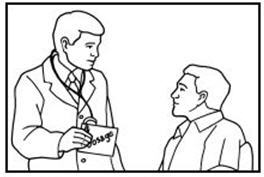
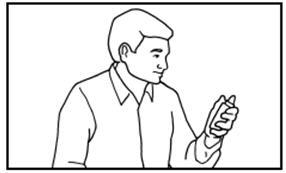
FOLLOW DOSAGE: WHAT TO EXPECT (First Week): - Use as directed by doctor.
- But do not use more than 5 times an hour or 40 times in 24 hours.
- Stop smoking completely during NICOTROL® NS treatment program.
- Hot, peppery feeling in back of throat or nose, sneezing, coughing, watery eyes, or runny nose.
- To Help Adjust to Spray—use regularly for first week.
- Side effects will lessen for most people in a few days—don't stop using the Nasal Spray. If side effects do not lessen after a week, call your doctor.
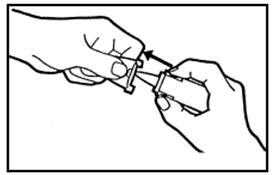
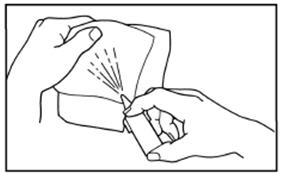
REMOVE CAP: PRIME PUMP (before first use): - Press in circles on sides of bottle.
- Pull off cap as shown.
- Get a tissue or paper towel.
- Hold bottle as shown.
- Press up on bottom with thumb.
- Pump into tissue until you see a fine spray (6 to 8 times).
- Throw tissue away.
FOLLOW DIRECTIONS EXACTLY — Questions? (call 1-888-642-6876) 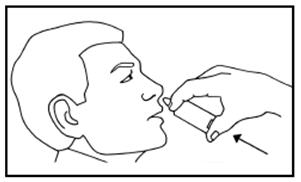
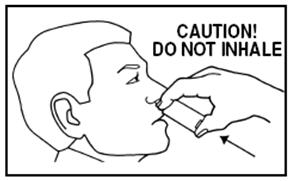
- Blow nose if it is not clear.
- Tilt head back slightly.
- Hold bottle as shown.
- Insert tip of bottle into nostril—as far as is comfortable.
- Breathe through mouth.
- Spray once in each nostril. Do not sniff or inhale while spraying.
- If nose runs, gently sniff to keep the Nasal Spray in nose. Wait 2 or 3 minutes before blowing nose.
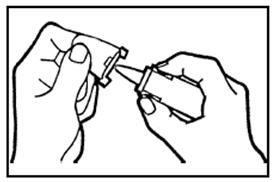
AVOID contact with skin, eyes, and mouth. If bottle breaks, wear rubber gloves, wipe up with paper towel and wash surfaces thoroughly. Do not let nicotine come in contact with your skin, mouth, or eyes. If it does, rinse with plain water immediately. Nicotine overdose can occur when nicotine is absorbed through the skin. If symptoms of overdose occur (see other side for symptoms), call a doctor or Poison Control Center. - Place cap back on bottle after use.
- Store at room temperature, 59°F to 86°F (15°C to 30°C), out of reach of children.
- If you don't use the Nasal Spray for 24 hours, prime pump in tissue 1 or 2 times.
- Most vials of NICOTROL® NS contain 100 doses (200 sprays), but excessive priming will reduce the amount of medicine available for use. Avoid excessive priming.
- 1.
NICOTROL® NS Nasal Spray is designed to help you quit smoking by reducing your urge to smoke. What causes the urge to smoke? It is the nicotine in cigarettes. NICOTROL® NS contains nicotine. Your doctor may increase or decrease dosage during the first few weeks. As your body adjusts to not smoking, your doctor will either tell you to stop using NICOTROL® NS or gradually reduce your dose.
- SPL UNCLASSIFIED SECTION
-
PRINCIPAL DISPLAY PANEL - 10 mg/mL Bottle Label
NDC: 0009-5401-01
Nicotrol®NS
(nicotine
nasal spray)10 mg/mL
FOR NASAL USE ONLY
KEEP OUT OF REACH OF CHILDREN10 mL
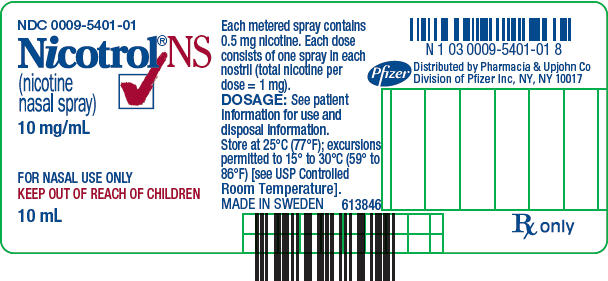
-
PRINCIPAL DISPLAY PANEL - 10 mg/mL Bottle Box
NDC: 0009-5401-01
Nicotrol® NS
(nicotine
nasal spray)10 mg/mL
Pharmacist: Place prescription label here.
This package contains prescribing information which includes patient instructions.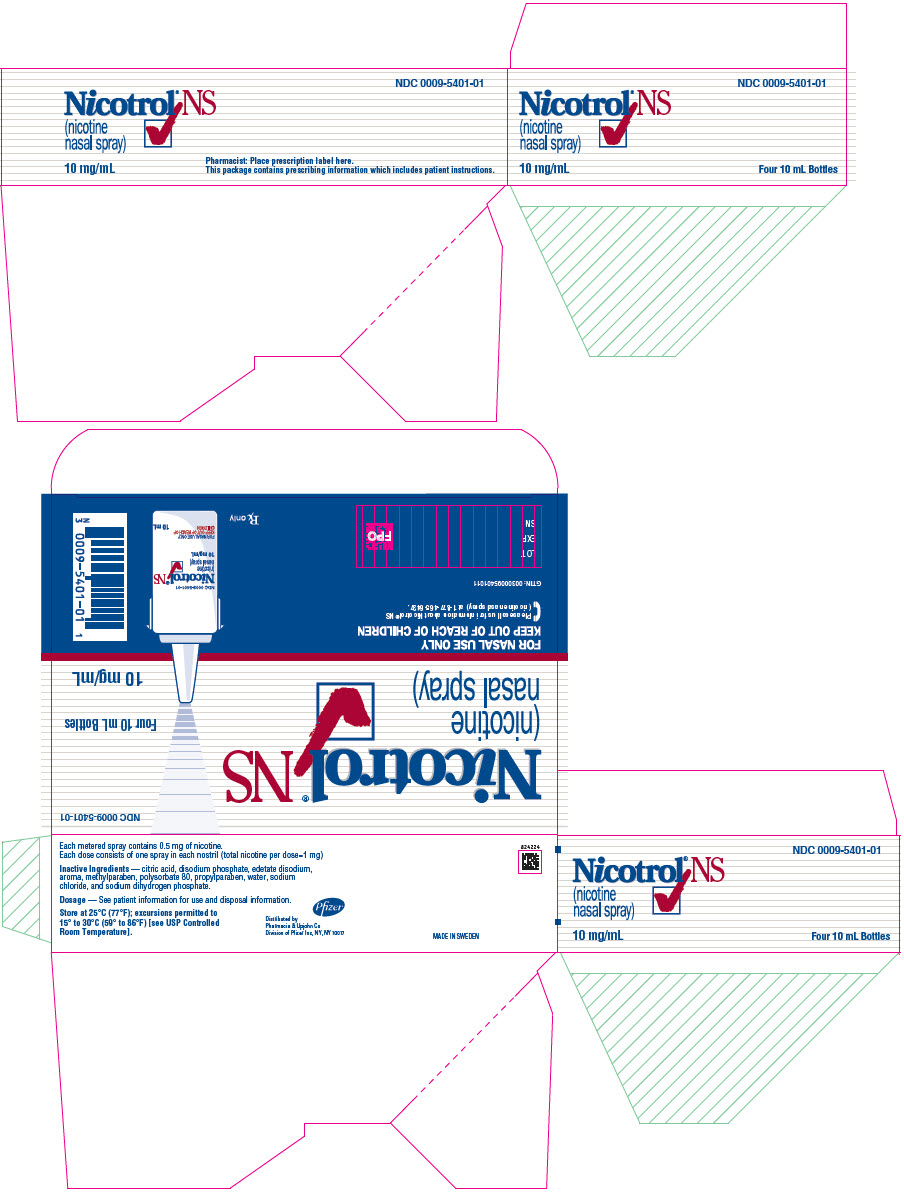
-
INGREDIENTS AND APPEARANCE
NICOTROL
nicotine spray, meteredProduct Information Product Type HUMAN PRESCRIPTION DRUG Item Code (Source) NDC: 0009-5401 Route of Administration NASAL Active Ingredient/Active Moiety Ingredient Name Basis of Strength Strength NICOTINE (UNII: 6M3C89ZY6R) (NICOTINE - UNII:6M3C89ZY6R) NICOTINE 10 mg in 1 mL Inactive Ingredients Ingredient Name Strength SODIUM PHOSPHATE, MONOBASIC, UNSPECIFIED FORM (UNII: 3980JIH2SW) CITRIC ACID MONOHYDRATE (UNII: 2968PHW8QP) METHYLPARABEN (UNII: A2I8C7HI9T) PROPYLPARABEN (UNII: Z8IX2SC1OH) EDETATE DISODIUM (UNII: 7FLD91C86K) SODIUM CHLORIDE (UNII: 451W47IQ8X) POLYSORBATE 80 (UNII: 6OZP39ZG8H) WATER (UNII: 059QF0KO0R) Packaging # Item Code Package Description Marketing Start Date Marketing End Date 1 NDC: 0009-5401-01 4 in 1 BOX 05/22/1996 1 10 mL in 1 BOTTLE, SPRAY; Type 2: Prefilled Drug Delivery Device/System (syringe, patch, etc.) Marketing Information Marketing Category Application Number or Monograph Citation Marketing Start Date Marketing End Date NDA NDA020385 05/22/1996 Labeler - Pharmacia and Upjohn Company LLC (618054084)
Trademark Results [Nicotrol]
Mark Image Registration | Serial | Company Trademark Application Date |
|---|---|
 NICOTROL 74006504 1733922 Live/Registered |
WARNER-LAMBERT COMPANY 1989-11-17 |
© 2025 FDA.report
This site is not affiliated with or endorsed by the FDA.
